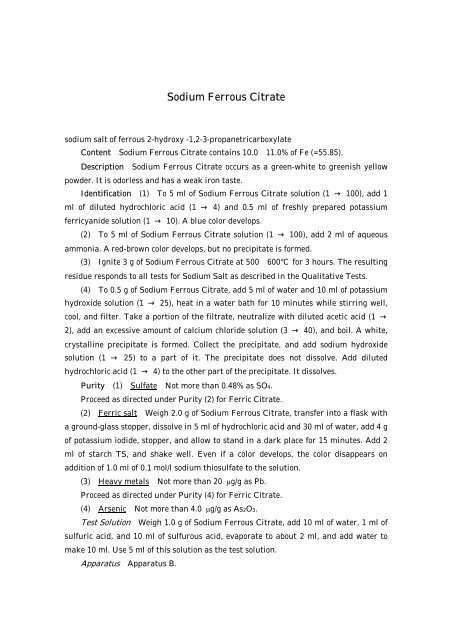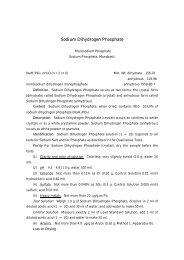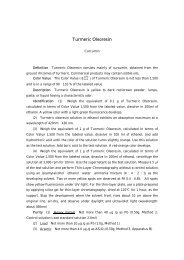Sodium Ferrous Citrate
Sodium Ferrous Citrate
Sodium Ferrous Citrate
You also want an ePaper? Increase the reach of your titles
YUMPU automatically turns print PDFs into web optimized ePapers that Google loves.
<strong>Sodium</strong> <strong>Ferrous</strong> <strong>Citrate</strong>sodium salt of ferrous 2-hydroxy -1,2-3-propanetricarboxylateContent <strong>Sodium</strong> <strong>Ferrous</strong> <strong>Citrate</strong> contains 10.011.0% of Fe (=55.85).Description <strong>Sodium</strong> <strong>Ferrous</strong> <strong>Citrate</strong> occurs as a green-white to greenish yellowpowder. It is odorless and has a weak iron taste.Identification (1) To 5 ml of <strong>Sodium</strong> <strong>Ferrous</strong> <strong>Citrate</strong> solution (1 100), add 1ml of diluted hydrochloric acid (1 4) and 0.5 ml of freshly prepared potassiumferricyanide solution (1 10). A blue color develops.(2) To 5 ml of <strong>Sodium</strong> <strong>Ferrous</strong> <strong>Citrate</strong> solution (1 100), add 2 ml of aqueousammonia. A red-brown color develops, but no precipitate is formed.(3) Ignite 3 g of <strong>Sodium</strong> <strong>Ferrous</strong> <strong>Citrate</strong> at 500600 for 3 hours. The resultingresidue responds to all tests for <strong>Sodium</strong> Salt as described in the Qualitative Tests.(4) To 0.5 g of <strong>Sodium</strong> <strong>Ferrous</strong> <strong>Citrate</strong>, add 5 ml of water and 10 ml of potassiumhydroxide solution (1 25), heat in a water bath for 10 minutes while stirring well,cool, and filter. Take a portion of the filtrate, neutralize with diluted acetic acid (1 2), add an excessive amount of calcium chloride solution (3 40), and boil. A white,crystalline precipitate is formed. Collect the precipitate, and add sodium hydroxidesolution (1 25) to a part of it. The precipitate does not dissolve. Add dilutedhydrochloric acid (1 4) to the other part of the precipitate. It dissolves.Purity (1) Sulfate Not more than 0.48% as SO4.Proceed as directed under Purity (2) for Ferric <strong>Citrate</strong>.(2) Ferric salt Weigh 2.0 g of <strong>Sodium</strong> <strong>Ferrous</strong> <strong>Citrate</strong>, transfer into a flask witha ground-glass stopper, dissolve in 5 ml of hydrochloric acid and 30 ml of water, add 4 gof potassium iodide, stopper, and allow to stand in a dark place for 15 minutes. Add 2ml of starch TS, and shake well. Even if a color develops, the color disappears onaddition of 1.0 ml of 0.1 mol/l sodium thiosulfate to the solution.(3) Heavy metals Not more than 20µg/g as Pb.Proceed as directed under Purity (4) for Ferric <strong>Citrate</strong>.(4) Arsenic Not more than 4.0µg/g as As2O3.Test Solution Weigh 1.0 g of <strong>Sodium</strong> <strong>Ferrous</strong> <strong>Citrate</strong>, add 10 ml of water, 1 ml ofsulfuric acid, and 10 ml of sulfurous acid, evaporate to about 2 ml, and add water tomake 10 ml. Use 5 ml of this solution as the test solution.Apparatus Apparatus B.
Standard Color To 4.0 ml of Arsenic Standard Solution, add 10 ml of water, 1 mlof sulfuric acid, and 10 ml of sulfurous acid. Proceed in the same manner as for the testsolution.(5) Tartrate Weigh 1.0 g of <strong>Sodium</strong> <strong>Ferrous</strong> <strong>Citrate</strong>, add 5 ml of water and 10ml of potassium hydroxide solution (1 15), heat in a water bath for 10 minuteswhile stirring well, cool, and filter. Measure 5 ml of the filtrate, add diluted acetic acid(1 4) to make it weakly acidic, then add 2 ml of acetic acid, and allow to stand for 24hours. No white, crystalline precipitate is formed.Assay Weigh accurately about 1 g of <strong>Sodium</strong> <strong>Ferrous</strong> <strong>Citrate</strong>, transfer into aflask with a ground-glass stopper, add 25 ml of diluted sulfuric acid (1 20) and 2 mlof nitric acid, and boil for 10 minutes. After cooling, add 20 ml of water and 4 g ofpotassium iodide, immediately stopper tightly, allow to stand in a dark place for 15minutes, add 100 ml of water, and titrate the liberated iodine with 0.1 mol/l sodiumthiosulfate (indicator: starch TS). Perform a blank test in the same manner.1 ml of 0.1 mol/l sodium thiosulfate = 5.585 mg of Fe
















